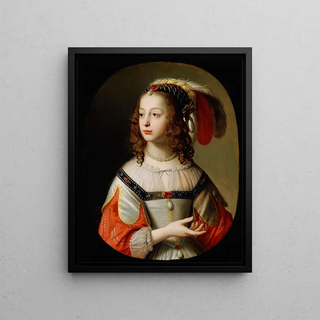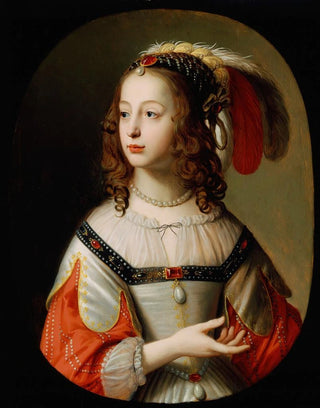Art print | Portrait of Sophie Palatine Princess - Gerard van Honthorst


View from behind

Frame (optional)
The "Portrait of Sophie Princess Palatine" by Gerard van Honthorst is an iconic artwork that embodies the very essence of Baroque portraiture. This 17th-century painting showcases a wealth of detail and psychological depth that captivate the viewer and invite contemplation. Through this art print, the artist succeeds in capturing not only Sophie’s appearance but also her essence, status, and character. The brilliance of the colors, the finesse of the features, and the subtle lighting that bathes the scene evoke an atmosphere that is both intimate and majestic, revealing the complexity of a woman who navigated the tumult of her era.
Style and uniqueness of the piece
Gerard van Honthorst’s style is distinguished by his masterful use of light, a fundamental element of the Baroque. In this art print, light plays a crucial role, illuminating Sophie’s face while creating delicate shadows that enhance the three-dimensionality of her features. This technique, known as chiaroscuro, gives the work an emotional intensity that captures the viewer’s attention. The details of the garments, richly decorated and carefully rendered, also testify to the artist’s exceptional craftsmanship. Every fold, every texture is rendered with precision, emphasizing the importance of the subject. Sophie’s expression, both gentle and resolute, suggests a complex personality—a woman of power and grace, whose gaze seems to carry the weight of history.
The artist and his influence
Gerard van Honthorst, born in Utrecht in 1592, is one of the masters of Dutch Baroque portraiture. Trained in the shadow of Caravaggio, he developed a distinctive style that combines realism and idealization. His influence has been significant, both in his homeland and abroad, where his works were prized by nobles and aristocrats. Van Honthorst innovated portraiture by incorporating narrative elements and psychological expressions, placing the subject at the heart of the composition. His approach paved the way for other artists, helping to shape the artistic landscape of the 17th century.

Matte finish

View from behind

Frame (optional)
The "Portrait of Sophie Princess Palatine" by Gerard van Honthorst is an iconic artwork that embodies the very essence of Baroque portraiture. This 17th-century painting showcases a wealth of detail and psychological depth that captivate the viewer and invite contemplation. Through this art print, the artist succeeds in capturing not only Sophie’s appearance but also her essence, status, and character. The brilliance of the colors, the finesse of the features, and the subtle lighting that bathes the scene evoke an atmosphere that is both intimate and majestic, revealing the complexity of a woman who navigated the tumult of her era.
Style and uniqueness of the piece
Gerard van Honthorst’s style is distinguished by his masterful use of light, a fundamental element of the Baroque. In this art print, light plays a crucial role, illuminating Sophie’s face while creating delicate shadows that enhance the three-dimensionality of her features. This technique, known as chiaroscuro, gives the work an emotional intensity that captures the viewer’s attention. The details of the garments, richly decorated and carefully rendered, also testify to the artist’s exceptional craftsmanship. Every fold, every texture is rendered with precision, emphasizing the importance of the subject. Sophie’s expression, both gentle and resolute, suggests a complex personality—a woman of power and grace, whose gaze seems to carry the weight of history.
The artist and his influence
Gerard van Honthorst, born in Utrecht in 1592, is one of the masters of Dutch Baroque portraiture. Trained in the shadow of Caravaggio, he developed a distinctive style that combines realism and idealization. His influence has been significant, both in his homeland and abroad, where his works were prized by nobles and aristocrats. Van Honthorst innovated portraiture by incorporating narrative elements and psychological expressions, placing the subject at the heart of the composition. His approach paved the way for other artists, helping to shape the artistic landscape of the 17th century.






